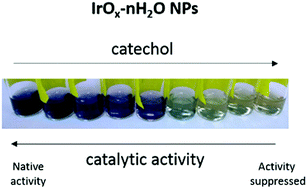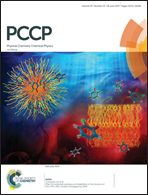Understanding iridium oxide nanoparticle surface sites by their interaction with catechol
Abstract
Iridium oxide (IrOx) is one of the best water splitting electrocatalysts, but its active site details are not well known. As with all heterogeneous catalysts, a strategy for counting the number of active sites is not clear, and understanding their nature and structure is remarkably difficult. In this work, we performed a combined study using optical spectroscopy, magnetic resonance and electrochemistry to characterize the interaction of IrOx nanoparticles (NPs) with a probe molecule, catechol. The catalyst is heterogeneous given that the substrate is in a different phase, but behaves as a homogeneous catalyst from the point of view of electrochemistry since it remains in colloidal suspension. We find two types of binding sites: centers A which bind catechol irreversibly making up 21% of the surface, and centers B which bind catechol reversibly making up 79% of the surface. UV-vis absorption spectroscopy shows that the A sites are responsible for the characteristic blue color of the NPs. Electrochemical experiments indicate that the B sites are catalytically active and we give the number of active sites per nanoparticle. We conclude by performing a survey of ligands used in solar cell architectures and show which ones bind well to the surface and which ones inhibit the catalytic activity when doing so, presenting quantitative guidelines for the correct handling of IrOx nanoparticles during their incorporation into multifunctional solar energy harvesting architectures. We suggest ligands binding on the surface oxygen atoms allow for large bound ligand densities with no detrimental effect on the catalytic activity.



 Please wait while we load your content...
Please wait while we load your content...